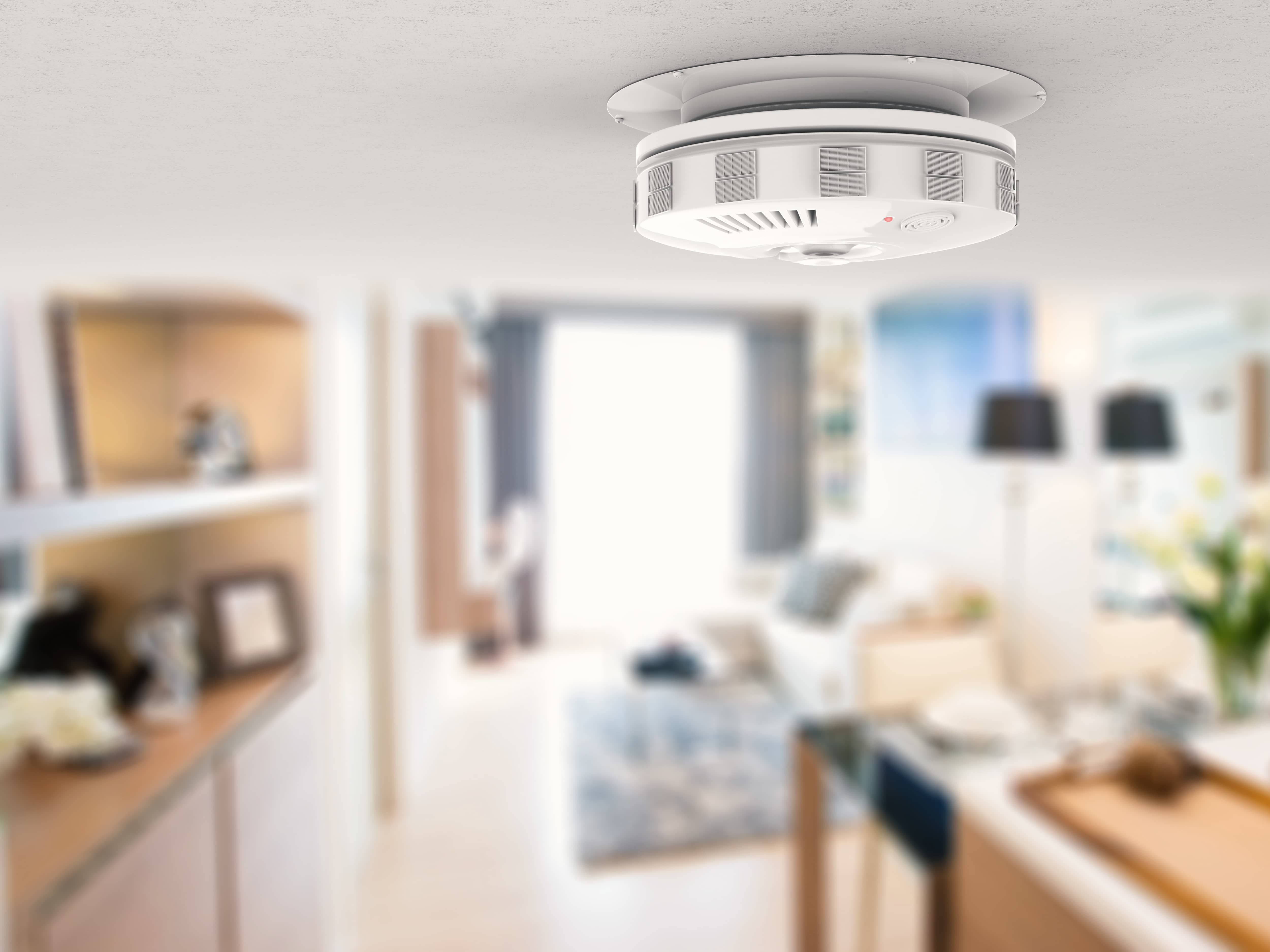
According to its annual report, the Philadelphia Fire Department responded to almost 300,000 emergency incidents in a recent year. House fires may be more common than you think – is your family prepared? Make sure with these home fire safety essentials
We grow up having fire drills in school, standing outside with our friends chatting and hoping our teacher forgot about the quiz we were supposed to have. We install smoke detectors and carbon monoxide detectors in our homes, but never really think we’ll hear them go off because of a real fire. At least we hope that’s the case. I know I didn’t dream I would have an actual house fire until it happened to my family.
I was at work on a Monday morning when I got a phone call from a friend who was called by my alarm company that our smoke detectors were going off. Thinking there must be a short in the wiring, I did not get frantic until my housekeeper phoned and said that the house was on fire. My children were at school and my housekeeper was able to get our dogs out to safety. By that time, fire trucks were on the scene and after several minutes, the fire was out.
As a parent, it’s important to know there are specific things that can be done to increase your home’s fire safety. If you take fire safety seriously, you can drastically improve the chances that your family escapes unharmed.
Every year in the United States, roughly 2,500 people die in house fires and 13,000 are injured. Most of these deaths occur in homes that did not have a working smoke alarm. The relatively low cost and lifesaving potential make the decision to buy and install smoke alarms an easy one.
Smoke Detectors: Battery-Operated Vs. Hardwired
There are two types of smoke detectors, namely battery-operated or hardwired.
Battery-operated smoke detectors are inexpensive and easy to install. It’s recommended you change batteries twice a year, but you should get in the habit of testing the battery every few months, perhaps at the beginning of every season. Most battery-operated alarms work independently and will not trigger other alarms, while some sync wirelessly with other alarms in the house.
Hardwired smoke alarms are a bit more expensive than battery-operated models, but are designed to be easy to install, easy to maintain and can provide years of maintenance-free protection. Of note, I would still check to make sure they’re working properly at the start of every season.
Having smoke alarms synced with a house alarm is of major benefit, as I can personally attest. The alarm company was notified, as well as the fire department, allowing them to make it to my house in a few minutes.
Carbon monoxide detectors and alarms are another essential for your home. This device detects the presence of carbon monoxide gas early enough to prevent poisoning. This compound is colorless and odorless, and is produced by incomplete combustion. It is virtually undetectable without a device, often referred to as a “silent killer.”
Other Home Fire Safety Essentials
Other essentials for home fire safety are safety ladders, fire extinguishers and a fire-resistant lockbox or safe.
Escape ladders are often overlooked, but essential for any multilevel home. They come in two- and three-story models and can be easily deploy from a standard windowsill. They come folded for compact storage (can tuck under bed or closet) but fully assembled and ready to use.
Every house should have a fire extinguisher in the kitchen. Make sure you have one specifically designed for home use and rated for typical household fires. Only an adult should use this and should be properly trained on use and maintenance.
While it’s not essential to have a fire-resistant lockbox, it’s highly recommended for storing valuable documents in case your home is ever damaged by fire. These may include birth certificates, passports, insurance papers as well as precious jewelry, family photos, etc.
How to Have a Family Fire Drill
When my kids were small, we had family fire drills every six months, our boys taking turns being the fire marshal. In the event of a fire, all members of the family must react immediately. Preparing and practicing a Family Escape Plan ensures everyone will know what to do.
As part of this plan, every room needs a name, and there should be two exits from every room. Sometimes this secondary exit becomes the difference between life and death. Make sure that if the secondary exit is a window, it’s easy to open and for a child to drop to the ground. If it’s on the second floor, think about purchasing a safety ladder.
Once outside, designate a meeting place. This should be in front of the home and close by, but not so close as to still be in danger. Pick a space such as a tree, a neighbor’s front porch or telephone pole.
Once a family has a plan, practice, practice, practice! Having a fire drill is most important and can be fun for the kids. Do often (change of seasons) and always tell housekeepers/babysitters the plan.
As part of drill, review the following rules:
- Do not return to the burning building once outside.
- Do not try to put out the fire, unless you see it is confined to very small area.
- When you hear the alarm, get out immediately. Don’t stop to dress, get valuables (that includes a favorite toy or stuffed animal!) or call the fire department. Call from a neighbor’s house.
- Never hide in a closet or under a bed where you can’t be easily located.
- Don’t rush into a hallway. Touch closed doors carefully. If hot, use an emergency exit. If not hot, open with caution. If fire and smoke is visible, close the door immediately as it takes several minutes for fire to burn down a door.
- If trapped, don’t panic, Cover vents with cloths and stuff cloths in door cracks. Call the fire department from a cell and tell them exactly where you are. Use a light or bed sheets to signal from a window if there is no ladder available.
- If the room is filled with smoke, get down on the floor and crawl. Cover your face with a cool, wet cloth if possible.
- Always close windows and doors behind you. This will slow down the fire’s spread.
Preventing Fires in the Home
While our house fire was electrical in nature, caused by a dehumidifier, below are tips to prevent fires in your home:
Kitchen
- Never fight a grease fire with water. Have a lid available for every pan in which a grease fire can start.
- Keep towels available and dry your hands before using electrical appliances.
- Turn pot handles inward on the stove.
- Wear close-fitting sleeves while cooking.
- Keep the stove and exhaust fan clean and grease free.
- Don’t hang clothes, dishtowels or decorative objects over the stove.
Laundry Room and Furnace Room
- Clean the lint trap after every load.
- Keep the area around the dryer free of lint.
- Replace furnace filters regularly. Clean dust and lint from around furnace motor and burners.
Bedrooms
- Be sure windows open easily.
- Plan two escapes from each bedroom.
Storage
- Never leave greasy or oily rags lying around.
- Store gasoline or other flammable substances in tightly closed metal containers.
- Keep basement and storage areas clean.
Electrical
- Don’t overload circuits. Avoid plugging more than two appliances into one outlet.
- If a fuse blows, find the cause.
- Don’t use extension cords under rugs, over hooks or through door openings.
Children
- Never leave children unattended.
- Don’t let kids play around stoves, open fires or electric heaters.
- Keep lighters and matches out of reach.
- Instruct babysitters what to do in case of fire.
As scary as all this is, being prepared is key! Have essentials in place, make a plan and practice! GOOD LUCK!
 33 Rock Hill Rd
33 Rock Hill Rd 1740 South Street
1740 South Street 2365 East York Street
2365 East York Street